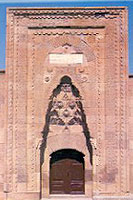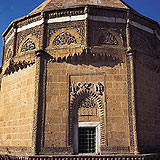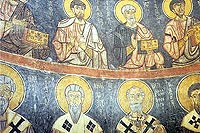Niğde
 Alaaddin Mosque (Center): The mosque was constructed during the period of Great Seljukian Monarch Sultan Alaaddin Keykubat by the Niğde Governor Ziynettin Beşare in 1223 on the Alaaddin Hill which is located in the city center. The mosque reflects the entire delicacy of the Seljukian adornment art and is especially the first and the interesting samples in the architectural scope.
Alaaddin Mosque (Center): The mosque was constructed during the period of Great Seljukian Monarch Sultan Alaaddin Keykubat by the Niğde Governor Ziynettin Beşare in 1223 on the Alaaddin Hill which is located in the city center. The mosque reflects the entire delicacy of the Seljukian adornment art and is especially the first and the interesting samples in the architectural scope.
The richest section of the mosque is the portal of the mosque which was constructed according to the sampling of the traditional Seljukian lean to roof examples. The major property of the portal facing east is that the shadows of the sun light directed by the portal at a given angle, at a specified hour and the minute (only in summer seasons between 10.00 - 11.00) forms a shadow in the form of „ Crowned Woman Head“. The mosque has a separate importance among the Seljukian architectural creations with this property. The portal is named as the „Crown Portal“because of this woman head with crown and knitted hair.
According to the legend, the master constructing the mosque had fallen in love with the daughter of the Niğde Governor of the time, namely the princess.
However the master has the consciousness that he would never marry with the princess. One day the Governor issues an order for the construction of a mosque in the city to the master. The master was also looking for a chance to tell his love to the princess. As to describe that his love to the princess would live forever, he processes the portrait of the princess excellently on the marbles of the portal. The old door of the mosque is exhibited in the museum. There is an epitaph in the form of reverse "T"constructed from the white marble on the door. The epitaph states that the creation was constructed in the year 620.
 Hüdavend Hatun Mausoleum (Center): The mausoleum is located in the Niğde city center and is one of the rarest creations of the Seljukian art. The mausoleum was constructed by Hüdavend Hatun, daughter of IV. Rükneddin Kılıçaslan, son of II. Gıyaseddin Keyhüsrev in 1312. The upper sites of the windows are engraved with the embossed designs of birds with human heads and various animals. There is the depiction of a timid gazelle beside a lion and there is another depiction of a double headed eagle with wings open condition (this eagle is the symbol of the Seljukians).
Hüdavend Hatun Mausoleum (Center): The mausoleum is located in the Niğde city center and is one of the rarest creations of the Seljukian art. The mausoleum was constructed by Hüdavend Hatun, daughter of IV. Rükneddin Kılıçaslan, son of II. Gıyaseddin Keyhüsrev in 1312. The upper sites of the windows are engraved with the embossed designs of birds with human heads and various animals. There is the depiction of a timid gazelle beside a lion and there is another depiction of a double headed eagle with wings open condition (this eagle is the symbol of the Seljukians).
The entrance to the mausoleum is via a portal which is splendid with the decorations and adornments. The mausoleum contains the tomb of Hüdavend Hatun whom had died in 1332 and two other tombs. The Mausoleum of Hüdavend Hatun, which does not have any artistic value, is one of the most important and most magnificent Seljukian creations in Anatolia.
Sungur Bey Mosque (Center): The Sungur Bey Mosque was constructed in 1335 by Seyfettin Sungur Bey, who was the Governor of Niğde during the period of İlhanlı civilization in the city center. The mosque has two main entrance gates located at east and north and a niche, and the original wooden embroidery of the northern gate is splendid.

Gümüşler Monastery (Center): The monastery is located nine kilometers away from the city center and four kilometers to the Niğde -Kayseri highway. The Rock engraved monastery is one of the beautiful creations of the 10th century Byzantine art and is one of the most preserved creations that could still remain until the present day. The monastery is dated to the 10th century and there are symbols that the construction of the monastery had continued between 8th and 12th centuries. There are frescos that are extremely well preserved and wonderfully colored inside the church. The frescos depict the birth of Jesus, the baptism of Jesus, the introduction to the church, the apostles and the notables of Christianity. At the niche to the left of the Abscissa, “the Smiling Mary and the infant Jesus“is depicted. This fresco was determined to be the only smiling Mary depiction in the whole Anatolia.